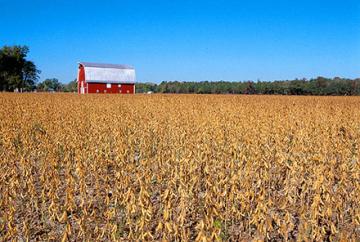USA
October 8, 2024

American agriculture accounts for about 10% of the nation’s greenhouse gasses. (Photo by Scott Bauer, ARS)
Climate change is a huge topic with so many moving parts that it’s hard to grasp in its entirety – the many causes, amount and speed of changes, and how to meaningfully combat it. But scientists in Fort Collins, CO, are developing strategies to help rein in agriculture’s role.
“Agriculture is responsible for about 10% of national greenhouse gas (GHG) emissions,” said Stephen Del Grosso, a soil scientist with the Agricultural Research Service’s (ARS) Soils Research section of the Soil Management and Sugarbeet Research Unit (SMSRU) in Fort Collins. “Our research investigates how land management, vegetation cover, soil biology, and weather determine crop yields and environmental effects, such as greenhouse gas emissions and soil carbon sequestration.”
The task is so large that it’s not feasible to directly measure the effects from all of the nation’s agricultural lands; it is simply too expensive to acquire the necessary instrumentation and technical expertise. Consequently, ARS operates research farms and pastures where they can make accurate measurements from DNA-to plant-to field levels. Scientists use that data to develop ecosystem models that can calculate GHG emissions and other impacts at farm, regional, and global scales.
“We use these observations to develop and test plant-soil system models that simulate how land management interacts with weather, soil type, and other factors to estimate GHG emissions, soil carbon storage, and losses of gaseous and soluble compounds from working lands that can compromise air and water quality,” Del Grosso said.
ARS researchers have already provided substantial tools to accurately estimate GHG emissions and implement practices that reduce these emissions through (adjective) programs. Those programs include Daily CENTURY (DayCent, a collaboration with Colorado State University) and the CaRPE tool (Carbon Reduction Potential Evaluation, a collaboration with Jennifer Moore, a soil scientist with the ARS Forage Seed and Cereal Research unit in Corvallis, OR).
“DayCent is a plant-soil system model that uses readily available information such as weather and crop management records to predict outcomes that are difficult to measure – such as nitrous oxide gas emissions from soils,” Del Grosso said.
It is crucial to demonstrate that DayCent can reliably represent the plant-soil system dynamics that control emissions of nitrous oxide, which acts as a greenhouse gas and contributes to ozone depletion in the upper atmosphere, Del Grosso explained. “The model is used to calculate soil emissions reported in the national GHG inventory, and recent improvements include representing nitrous oxide pulses that are triggered by the thawing of cropped and grazed soils during springtime in cold climates. DayCent simulations with this enhancement resulted in a 22% increase in estimated emissions for this gas compared to previous versions of the GHG inventory.”
CaRPE tool is a web-based interactive tool that integrates two databases (at county and multi-county scales) to visualize and estimate the climate benefits of implementing a variety of conservation practices on croplands and grazing lands. It works by calculating carbon sequestration and GHG emission reduction [rates] associated with climate-smart agricultural management practices.
“CaRPE [helps us] estimate potential carbon reductions and implementation costs based on user estimates of conservation practice adoption,” said Daniel Manter, a soil scientist at SMSRU. “By including geographically-based (county) estimates, users can determine the practices and regions where adoption may have the most impact.”
Estimates are available for conservation management practices on either cropland or grazing lands depending upon the practice selected, Manter said. CaRPE data has been featured in several major reports, and in Moore’s testimony to the U.S. House Select Committee on the Climate Crisis, where experts summarized the potential benefits of increased adoption of conservation tillage and cover crops.
Crop and livestock producers, policy makers, environmental organizations, and others can use these decision support tools to estimate the potential of different management strategies to reduce GHG emissions, increase soil carbon stocks, and enhance air and water quality.
According to Del Grosso, the project is helping researchers establish reliable baseline emission estimates so they can determine if current reduction practices are effective and to make any necessary improvements for future mitigation. – by Scott Elliott, ARS Office of Communications